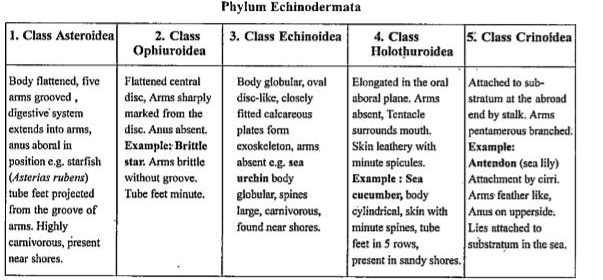Describe the characters of phylum Echinodermata. Name its class with examples.
Text Solution
Phylum Echinodermata. Term "Echinodermata" was coined by J.Klein. He included sea urchins in this group. Later, sea-stars, brittle stars, sea-cucumbers and sea-lilies were also included in this phylum. Now, it includes about 6000 living species, and over 13,000 extinct species. These are characterized by a number of peculiar features which are not found in other phyla, and have unique combination of advanced and primitive characters. Echinodermates have following characters :
1. Habitat. The echinoderms are exclusively marine and occur in all seas from the intertidal zone to the great depths (even below 3600 metres). Most of these are benthonic while a few are pelagic or sedentary eg. Antedon (sealily). Some are found completely buried in sandy bottom eg Thyone.
2. Organisation. They have organ level organisation.
3. Symmetry. Adults have pentamerous radial symmetry while larvae are bilateral symmetrical.
4. Germ Layers. These are triploblastic animals.
5. Coelom. These are true coelomates and enterocoefomates. Coelom is filled with a coelomic fluid containing nutrients and amoeboid corpuscles called amoebocytes or coelomocytes. Coelomic fluid helps in respiration, excretion and circulation. To
6. Body form. Body shape varies considerably and may be globular (eg. Echinos), circular (eg. Echinorachinus) heart shaped (eg." chinocardium), elongated and cylindrical (eg. Cucumaria), star shaped (eg. Asterias, Pentaceros) or with branched feathery arms (eg. Antedon).
7. Body surface. Body surface in sea urchins, star fishes and brittle stars is covered by large number of spines which are generally immovable and protective in function while in the echinoids, the spines are large and movable to help in locomotion.
8. Head. It is absent.
9. Tube feet. These are present which help in locomotion and respiration.
10. Body wall. The body wall consists of a single-layered epidermis lying on a basal lamina, dermis, musculature and ciliated peritoneum. The epidermis generally consists of monociliated and nonciliated cells and secretes cuticle outside it. The dermis is composed of collagenous connective, tissue.
11. Endoskeleton. In echinoderms, endoskeleton is mesodermal in origin and is formed of calcareous plates called derinal ossicles. These ossicles may be separate from one another or fitted into one another to from a shell usually called theca or testa as in the sea urchins and sand dollar.
12. Water vascular system. It is also called ambulacral system and is the most characteristic feature and consists of tubes filled with a watery fluid. It is a specialized part of coelom and helps in locomotion and feeding. Water enters in this system through a porous plate called madreporite.
13. Digestive tract. The digestive tract is a complete and simple except brittle star.
14. Respiration. The gas exchange structures vary in different groups and seem to have arisen independently in various classes. Besides tube feet that carry on gas exchange in all echinoderms, there are dermal branchiae (papulae), bursae, peristomial gills, respiratory trees for respiration in different classes.
15. Circulatory system. The circulatory system is greatly reduced and is of open type. It is called haemal system. Blood is generally without a respiratory pigment. There is no heart or pumping vessel. Axial gland acts as heart. The circulatory system has little role in gas transport. There is also perihaemal system.
16. Excretory system. There are no excretory organs. Nitrogenous waste, which is ammonia or amino acids is lost by diffusion through the thin areas of body such-as tubefeet, gills, respiratory trees, etc.
17. Nervous system. The nervous system includes a circumoral nerve ring and radial nerve cords. There is no brain.
18. Sense organs. These are simple.
19. Reproduction. Sexes are mostly separate. Males and females are alike externally. The reproductive tracts are very simple. Fertilization is mostly external. Some forms reproduce asexually by self-division,
20. Development. The eggs are typically homolecithal. Development is indirect. Cleavage is radial and indeterminate, Gastrulation primarily occurs by invagination. Life history includes a ciliated, bilaterally symmetrical larva, that swims and feeds by means of ciliated bands, and undergoes metamorphosis. The common larvae are auricularia, bipinnaria, brachiolaria etc.
21. Power of Regeneration . It is very high.

|
Updated on:21/07/2023
Similar Questions
Knowledge Check
- Question 1 - Select One
Diagnostic character of the phylum Echinodermata is the presence of
Aspiny skinBpedicellariaeCwater vascular systemDAll of these
Name three classes of phylum ceolenterata.
View SolutionDiscuss the characters of the phylum Mollusca or Echinodermata.
View SolutionDiagnostic character of the phylum Echinodermata is the presence of
View SolutionWrite four distinguishing characters of phylum-Echinodermata.
View SolutionWrite four distinguishing characters of phylum - Echinodermata.
View SolutionWrite four distinguishing character of phylum-Echinodermata.
View SolutionWrite four distinguishing characters of phylum - Echinodermata .
View Solution

